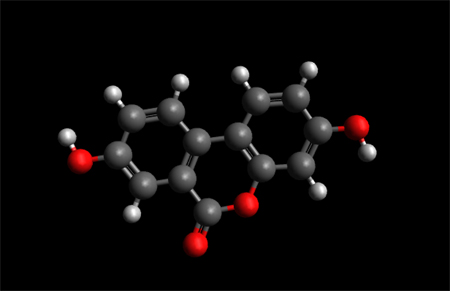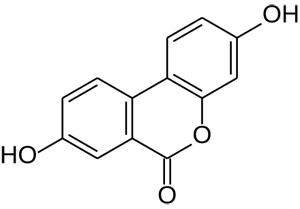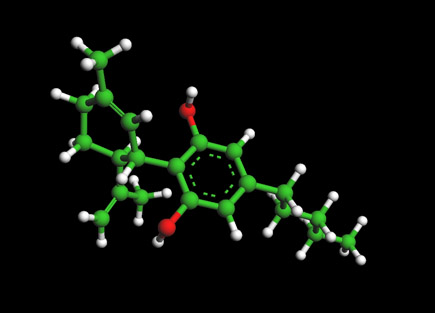Urolithin as a Senolytic and Anti-Aging Molecule
Molecule Urolithin A found in pomegranates may improve muscle strength and endurance during aging ...
"Pomegranates slow down the ageing process by prompting cells to recycle and rebuild themselves, a study shows"..source

Ball and Stick Model for Urolithin A Molecule
see Urolithin Molecule in 3D using Jsmol
About Urolithin
Urolithin A is a metabolite produced by the human gut microbiota upon dietary intake of plant derived ellagitannins and ellagic acid. Urolithins belongs to the class of organic compounds known as benzo-coumarins or dibenzo-α-pyrones. Its precursors – ellagic acids and ellagitannins – are ubiquitous in nature, including edible plants, such as pomegranates, strawberries, raspberries, and walnuts.
The particular bacteria that creates urolithin some people have and some do not. See: Isolation of Human Intestinal Bacteria Capable of Producing the Bioactive Metabolite Isourolithin A from Ellagic Acid
"...To date, only two urolithin-producing strains, Gordonibacter urolithinfaciens CEBAS 1/15P and Gordonibacter pamelaeae DSM 19378, have been identified [137, 138]. However, these strains cannot produce the downstream products urolithin A and urolithin B. Unraveling the bacterial phyla or group of bacteria responsible for production of these compounds is of great interest since they can be potentially used as probiotics [139]. Consumption of foods containing ellagic acid is also associated with health beneficial effects, and they could be mediated by the presence of urolithin-producing microorganisms [77]. Probiotics able to produce or to increase species related to the production of urolithins or other phytoestrogens such as equol and enterolignans can mean a step forward in the probiotic interventions, increasing the bioavailability of these compounds, and subsequently their therapeutic applications... See: Probiotic Bacteria for Healthier Aging: Immunomodulation and Metabolism of Phytoestrogens-October, 2017. And references therein.
Chemical structure of urolithin A

Abstracts:
Since the 2000s, urolithin A has been subject of several preliminary studies regarding its possible biological effects.
Pomegranate compound with anti-aging effects passes human trial
Urolithin A, a metabolite of biomolecules found in pomegranates and other fruits, could help slow certain aging processes. EPFL spin-off Amazentis, in conjunction with EPFL and the Swiss Institute of Bioinformatics, has published a paper in the journal Nature Metabolism outlining the results of their clinical trial.
The group identified a molecule that, managed to re-establish the cell's ability to recycle the components of the defective mitochondria: urolithin A. "It's the only known molecule that can relaunch the mitochondrial clean-up process, otherwise known as mitophagy," says Patrick Aebischer, co-author on the study. "It's a completely natural substance, and its effect is powerful and measurable."
See Abstract below.
02 July 2019-- First Human Clinical Trial Results on the Anti-Aging Compound, Urolithin A, Published by Amazentis and Researchers from the EPFL and SIB
Lausanne, Switzerland, June 14, 2019 -- Amazentis, an innovative life sciences company pioneering scientific breakthroughs in nutrition to manage health conditions linked to aging, announced today a collaborative publication in Nature Metabolism with scientists at the École Polytechnique Fédérale de Lausanne (EPFL) and the Swiss Institute of Bioinformatics (SIB) demonstrating the Company’s lead product, Urolithin A (UA), is safe, bioavailable and improves mitochondrial and cellular health in humans. UA was orally administered in both single and multiple (4 weeks) daily dosing to 60 healthy elderly subjects in a double-blind, randomized, placebo-controlled study. The trial showed that regular UA dosing during 4 weeks is safe, bioavailable and effective in improving mitochondrial health through upregulation of mitochondrial gene expression localized to the skeletal muscle and by improving systemic plasma acylcarnitines associated with cellular and mitochondrial function. Roger Fielding, PhD, Professor of Nutrition and Medicine at Tufts University, commented, “Other than exercise, there are currently no effective solutions to treat age-related decline in muscle function. This is an important study that shows that the metabolite of ellagitannins, Urolithin A, upregulates specific genes involved in mitochondrial protein synthesis and may be a possible avenue for improving muscle health in older adults.” “Mitochondrial and cellular health declines with age, making these results a pivotal milestone as we explore the full breadth of benefits Urolithin A offers for managing human health throughout the aging process,” stated Patrick Aebischer, MD, co-author on the article, EPFL President Emeritus, and Chairman and Co-founder of Amazentis. “These latest findings, which build on previous preclinical trials, really crystallize how UA could be a game-changer for human health,” added Johan Auwerx, MD, PhD, co-author and Professor at the EPFL. Nestlé Health Science recently announced a global partnership with Amazentis to develop products containing UA to pursue opportunities in consumer healthcare and medical nutrition. Chris Rinsch, PhD, lead author, Co-founder and CEO of Amazentis, said, “The rigorous clinical science being published in Nature Metabolism is a critical step towards translating our breakthrough scientific discoveries in nutrition into clinically validated consumer health products that address today’s unmet needs for healthy aging.” The results are being reported in the current issue of Nature Metabolism in an article titled, “The mitophagy activator Urolithin A is safe and induces a molecular signature of improved mitochondrial and cellular health in humans” (doi: 10.1038/s42255-019-0073-4).
14 June 2019 --The mitophagy activator urolithin A is safe and induces a molecular signature of improved mitochondrial and cellular health in humans
Urolithin A (UA) is a natural dietary, microflora-derived metabolite shown to stimulate mitophagy and improve muscle health in old animals and in preclinical models of aging1. Here, we report the results of a first-in-human clinical trial in which we administered UA, either as a single dose or as multiple doses over a 4-week period, to healthy, sedentary elderly individuals. We show that UA has a favourable safety profile (primary outcome). UA was bioavailable in plasma at all doses tested, and 4 weeks of treatment with UA at doses of 500 mg and 1,000 mg modulated plasma acylcarnitines and skeletal muscle mitochondrial gene expression in elderly individuals (secondary outcomes). These observed effects on mitochondrial biomarkers show that UA induces a molecular signature of improved mitochondrial and cellular health following regular oral consumption in humans... source.
17 June 2019 --Antiaging Effects of Urolithin A on Replicative Senescent Human Skin Fibroblasts
"...Although the health benefits attributed to urolithin A, such as anticancer, anti-inflammatory, and antioxidant effects, are based on numerous, diverse studies carried out in vitro, the biological effects of urolith A are still not entirely understood. In this study, we explored the biological effects of urolithin A using senescent human skin fibroblasts (HSFs) to determine whether urolithin A has any antiaging potential. Our results showed that urolithin A significantly increased type I collagen expression and reduced matrix metalloproteinase 1 (MMP-1) expression. Urolithin A also reduced intracellular reactive oxygen species, which may be partially due to activation of the Nrf2-mediated antioxidative response. These results indicate that urolithin A is a promising antiaging agent. Meanwhile, we noticed that the 50 μM urolithin A could cause changes in cell morphology and inhibition in cell proliferation, which were due to cell cycle arrest in G2/M phase. However, SA-β-gal (senescence-associated β-galactosidase) staining and γH2AX immunofluorescence staining showed cellular senescence status of HSFs did not change. Results of DAPI (4'6-diamidino-2-phenylindole) staining (no significant change) increased BCL2 gene expression and mitochondrial membrane potential (no significant change) after urolithin A treatment showed that the cells did not undergo apoptosis. These results provided further insights into the molecular mechanism of urolithin A. In conclusion, urolithin A showed a strong potential of antiaging..."
source
Anti-Aging and Senolytics Home Page
- What is Anti-Aging Medicine
- What is Senescence?
- What are Senolytics?
- About Caloric Restriction
- Mtor and Rapamycin
- The IKK/NF-κB signaling pathway in aging
- Exercise and Anti-Aging
- Meditation and Anti-Aging
SENOLYTIC AND ANTI-AGING MOLECULES
RAPAMYCIN ---The mechanistic target of rapamycin (mTOR) pathway has a central role in cell activation...
METFORMIN -- The diabetes drug metformin used by some for anti-aging may diminish benefits of aerobic exercise...
QUERCETIN-- AND WITH DASATINIB--The senolytic cocktail, dasatinib plus quercetin, which causes selective elimination of senescent cells...
FISETIN--Of the 10 flavonoids tested, fisetin was the most potent senolytic...
EGCG- The most active component of green tea....
NAD BOOSTERS --'...The cells of the old mice were indistinguishable from the young mice, after just one week of treatment...
SULFORAPHANE-- An isothiocyanate present in cruciferous vegetables activates antioxidant and anti-inflammatory responses by ...
UROLITHIN --Metabolite of Pomegranate compound with anti-aging effects passes human trial...
MITO-Q -- A water soluble fomr of CoQ10 that has excellent absorption and high bioavailability...
HONOKIOL - A bioactive natural product derived from Magnolia Bark have demonstrated ...
CURCUMIN AND ANALOGS -Recent research is focused on the design and synthesis of curcumin analogs as antiproliferative and anti-inflammatory agents...
BERBERINE --berberine has recently been reported to expand life span in Drosophila melanogaster, and attenuate premature cellular senescence
N-ACETYL-CYSTINE (NAC)--"...pretreatment with NAC increased glutathione levels in the older cells and largely helped offset that level of cell death..."
PIPERLONGUMINE - A natural product from the Long pepper with high bioavailability...
RESVERATROL AND PTEROTSILBINE -- Pterostilben chemically similar to resveratrol bute differs from resveratrol by exhibiting increased bioavailability (80% compared to 20% in resveratrol)
SPERMIDINE--Spermidine delays aging in humans ...
ALLICIN -- Allicin is a compound produced when garlic is crushed or chopped. ...
VITAMIN D3 -- Production of the active forms of Vitamin D are reduced by 50% as a result of an age-related decline
VITAMIN K-- evidence suggests vitamin K has an anti-inflammatory action
TOCOTRIENOL(AND WITH QUERCETIN) --Tocotrieniols have been found to exert a synergistic antitumor effect on cancer cells when given in combination....
HSP-90 INHIBITORS --As a novel class of senolytics
The Cannabidiol Molecule
Cannabidiol (CBD is the major non-psychoactive component of Cannabis and is being looked at by major drug and consumer companies for various medical and social uses.